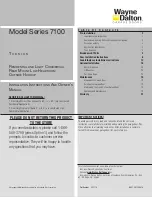
9
CONNECTING THE GEAR MOTORS TO THE LOGIC CONTROLLER
Each gear motor comes with a flexible electrical lead attached with two cores, negative and positive. This lead needs to be connected to
motor 2 output (MOT2), and in the case of dual gates also motor 1 output (MOT1) in the control board. NB: Motor 2 is used for single gate
installations and in the case of double gates is the gate you may wish to attach an electric lock to as it opens first and closes last. If the
control board is positioned close enough it may be possible to connect one motor directly to the control board without joining and/or
extending the cable using a suitable cable gland to enter the control board enclosure. In most cases it will be necessary to install electrical
conduits and junction boxes to join and extend your motor cables using suitable two core cable. Your Automatic Solutions store can
provide the cable or a good local source is generally the large automotive accessory stores as most motor vehicles run 12 and 24 volt
systems. We recommend 5mm low voltage cable. No cable run should exceed 10 metres without planning for voltage drop. Ensure all
joins are protected from the weather using suitable junction boxes, conduits are adequately clamped and cables are tied to avoid dragging
or catching.
Once you have run your motor cables you should have two cores, or in the case of dual gates four cores inside your logic control enclosure
and the obvious question is which wire goes into the left terminal and which goes into the right terminal of the motor outputs. There is no
easy way of knowing and the answer is it does not matter, we will find out in the next stage and make changes as required then. Make
sure you have no power connected to the control board and you can now connect your motor/s to the outputs (MOT2 and/or MOT1) paying
attention to which motor will be motor 2 which will open first if so programmed when dual gates overlap. With single gates use motor 2
output only.
INSTALL YOUR INPUT LOOPS
The only other wiring needed before testing your installation is to install a few loops into the “NC” or normally closed inputs. Cut three short
lengths (50mm) of single core cable and strip the two ends. Connect one end to the “photo” terminals and one end to the “com” terminal.
Do the same with the “stop” terminal and the “com”. These will need to be removed later if you add safety beams (photocells) or a stop
button to your installation but for now will close the inputs and make the board operational.
Note: Although we have stated above that we need to install loops into the normally closed inputs and you may note that the limit switch
inputs are normally closed it is not necessary to install loops into these inputs. The board tests these inputs for the presence of limit
switches and excludes them automatically when they are not found.
FIT AN ANTENNA WIRE
If you intend using a full antenna, install this now into the antenna terminals taking care not to allow the shield to make any contact with the
core of your coaxial. Otherwise cut a small length (150mm) of light cable and strip one end. Place the stripped end into the right hand
antenna terminal and secure.
SET YOUR DIP SWITCHES AND JUMPERS
Set your dip switches as per the settings below.
Single Gate Initial Settings
ON
3
7
10
OFF
1
2
4
5
6
8
9
Double Gate Initial Settings
ON
7
10
OFF
1
2
3
4
5
6
8
9
Ensure that jumper “JP1” the clip is installed to cover the 12 Volt pins and the same thing on jumper “JP2”.
CONNECT BATTERY
If you are using backup battery you will need to make two leads with male spade connectors at each end and connect your battery to FS1
and FS2 on the board. Pay attention to polarity – positive to positive and negative to negative.
CONNECT POWER
You can now plug your logic control board into the 240 volt power outlet or have your electrician connect your power via a suitably installed
isolation switch and turn your power on.
Содержание CTR50
Страница 1: ...1 SWING GATE INSTALLATION MANUAL AUTOMATIC ...
Страница 19: ...19 ...
Страница 20: ...20 ...








































